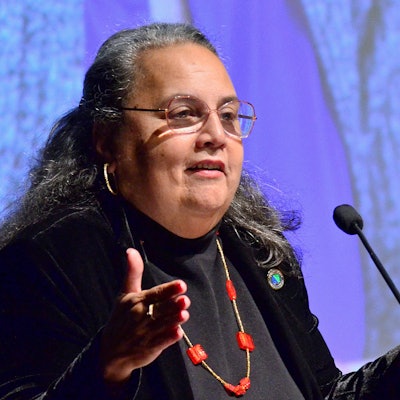What started with a small workshop during women’s history month turned into the first annual Latinas in Higher Education Conference held at Bronx Community College (BCC) in New York City during Hispanic Heritage Month.
 Dr. Daisy Cocco De Filippis, Dominican-American author and president of HSI Hostos Community College in the South Bronx.
Dr. Daisy Cocco De Filippis, Dominican-American author and president of HSI Hostos Community College in the South Bronx.
“Statistically, in higher education, less than 2% of full-time faculty members are Latinas,” said Leidy K. Pichardo, associate director of BCC’s college discovery program and chairperson of the Association of Latina Faculty and Staff (ALFS), a support organization that advocates for Latinx faculty, staff and students at BCC. Pichardo co-organized the event with ALFS vice chairperson and BCC chief information officer Luisa Martich in just four months—and they are already planning for next year.
“BCC is a Hispanic Serving Institution (HSI). That’s important. Fifty-eight percent of our student population is of Latino descent,” said Pichardo. “We wanted to expose the talent of our faculty and staff of BCC and other community colleges, the wonderful work that’s being done, on behalf of Latina faculty and staff.”
Keynote speaker Dr. Daisy Cocco De Filippis, Dominican-American author and president of HSI Hostos Community College (HCC) in the South Bronx, spoke about the inequity experienced by Latinx female faculty members, from their sheer lack of numbers to salary discrepancies.
“Look around. Look at our salaries—women tend to gravitate toward community colleges—the majority of women [academic] presidents in the nation are women,” said Cocco De Filippis. “And they get paid about $100,000 less than men who teach at universities and senior colleges.”
Event presenters offered attendees, virtual and present, ways to build a culture of belonging and retain Latinx women in science, technology, engineering, and math (STEM) fields, and shared how intrusive advising played a key role in tripling BCC’s three-year graduation rate from 7% to 20% in just a decade.
 Leidy K. Pichardo, associate director of BCC’s college discovery program and chairperson of the Association of Latina Faculty and Staff.
Leidy K. Pichardo, associate director of BCC’s college discovery program and chairperson of the Association of Latina Faculty and Staff.
The NSF HSI Improving Undergraduate STEM Education (NSF HSI IUSE) program, or transfer collaborative, is an articulation agreement between City Tech and six CUNY community colleges, including BCC and HCC. It ensures STEM students have a smooth transition into the four-year program.
The transfer collaborative gives students a $127 monthly stipend, a MetroCard, early registration, access to professional development workshops, and targeted, personal advising. In fall 2021, transfer collaborative student demographics were overwhelmingly male, with just 38% identifying as female. But by the following year, that number grew to 46%.
“My strategy, I went to my data department at City Tech, and I specifically asked from criteria of transfer students with associate degrees, specifically from [HSI] community colleges, and I specifically asked for gender as well,” said Roger Brian Mason, transfer collaborative program manager at City Tech. “Our initiative and our goal are to increase women and underrepresented groups in STEM, right? That was intentional. That was planned.”
Intrusive advising has proved to be successful in another CUNY program, Accelerated Study in Associate Program (ASAP). ASAP was initiated 15 years ago to shorten the time it took CUNY community college students to earn their degrees or certificates to three years or less.
BCC’s ASAP advisors Nicole Benjamin and Jasmine Caccavelli-Garcia Martinez said they think of a student’s journey like a baseball field. Students will travel through the bases, (in this case, co-curricular activities, professional development, and academic support services), but they eventually always come back to home base.
Home base is the monthly one-on-one conversation each ASAP advisor has with their 150 students. They discuss long-term and short-term goals, learn about and create social activities Latina students want to attend, and keep them on track to graduate. The ASAP advisors stay with their students from day one to graduation.
“In higher education, we know that if students feel belongingness to the institution they are in, they will stay,” said Melanie Robles, ASAP Associate Director at BCC. “Begin at the very beginning to engage that, from walking through door to admissions, acclimating and onboarding with orientation. Making sure this experience is memorable will make 100% difference. Everything you do impacts retention.”
Liann Herder can be reached at [email protected].
Editor’s Note: Due to a reporting error, we incorrectly identified Melanie M. Robles as an ASAP Advisor. She is ASAP Associate Director at Bronx Community College. The story has been updated. Diverse regrets the error.
















